Displaying items by tag: Tom Walsh
#inss – Last week, Sailing on Saturday featured the Royal Cork Yacht Club, the oldest in the world, as it comfortably donned the mantle of the ISA/Mitsubishi Motors Sailing Club of the Year 2015. This morning, we find ourselves involved with what may well be the newest sailing club in the world, the Irish National Sailing Club. It is certainly, thanks to being inaugurated nearly three months after Youghal SC was founded on 28th October 2014, the newest in Ireland. W M Nixon tries to explain it all as he finds himself in the world of Irish sailing's most complete dynamo.
Alistair Rumball is a Life Member of the Awkward Squad. Cage-rattling and pot-stirring are second nature to him. But it's not because of experiencing an unhappy childhood. On the contrary, while growing up in Malahide, his boyhood summers were bliss. He and his brother Arthur had as much sailing as they could want, fitted in between part-time jobs raising pocket-money with a morning picking potatoes at Dermot Dickie's farm along the Broadmeadow Estuary, followed by an afternoon of sailing the sea with the sun always shining, and then maybe an evening of club racing followed by the easy camaraderie among kids who are comfortable with boats.
It was an idyllic maritime environment which, over the years, has produced some of Ireland's top racing and cruising sailors. But while the young Rumball was no slouch on the race-course, the strongest feeling he had about sailing was the sheer fun of it all, the totally absorbing wonder of being in a boat and hauling on ropes to make sails change shape and help you along your chosen course over the always interesting sea.
Although he graduated from Trinity College Dublin as an engineer, he increasingly had this almost evangelical attitude to spreading the good news about the fun of sailing. And while he has something of a reputation – to say the least - for being confrontational, it's central to his contradictory character that he's an extremely good teacher. If somebody shows the slightest genuine enthusiasm about wanting to learn to sail, Alistair Rumball has been prepared to go to endless lengths to teach him or her to do so, and to do so with enjoyment.
Underlying that, we find the first of his gripes about the modern sailing scene. He reckons that it has become far too serious. Don't think for a moment, though, that he believes in a frivolous approach to boats and sailing. He's deadly serious about having everything just right as regards safety and function.
But once that's sorted, then he firmly believes that you should go out and enjoy it. He waxes lyrical about moments of sheer sailing ecstasy he has enjoyed in a wide variety of boats in many sailing locations worldwide. And whatever he may have formally set out to be in a professional career, his working life has been spent in and around boats, getting people introduced to boats and out afloat, sometimes on an almost industrial scale.
Time was when sailing skills were something you acquired by a sort of osmosis through family tradition, club opportunities, and friendship examples. That's mostly how Rumball himself learned to handle a sailing boat. But he seems to have this almost messianic zeal to teach people to sail, and he became convinced that the future lay in more structured training with a proper syllabus.
Having taken a long hard look at the population distribution of the Greater Dublin area and where they might best get afloat in worthwhile numbers, in 1978 he acquired the assets of a moribund organisation, the Dun Laoghaire Sailing School, and soon found himself giving his first lessons to two pupils using a fibreglass-clinker Darragh 14 knockabout sailing dinghy which they'd launched from the public slipway in the Coal Harbour in Dun Laoghaire. The long journey had started towards an organisation whose activities today today include top-of-the-line race training in 1720s in winning mode:
The majestic granite harbour of Dun Laoghaire was a cold place in 1978 for any young enthusiasts trying to set up an independent sailing school on a commercial basis. For the powers that be, sailing was something to be learned through family and clubs under the Junior Training Programme of the Irish Yachting Association. If you were a young person or adult from a non-sailing background but keen to learn, unless you'd an obliging and patient friend from within the sailing establishment, the expectation was that you'd take yourself off to somewhere far away like the Glenans Ireland bases in Baltimore and Bere Island and Clew Bay, and eventually reappear after a decent interval with enough experience, newfound ability and contacts to make the grade in the Dublin Bay sailing scene, where the very thought of a raw in-harbour sailing school for outsiders seemed distasteful to the establishment.
Yet hidden away in the southwest corner of Dun Laoghaire harbour, here was this gadfly of the sailing scene, Can–do Alistair with his rough and ready sailing school enthusiastically recruiting pupils anywhere and everywhere, and taking them afloat in boats which may not have been in the most pristine condition, and certainly set sails which would not be winners on the race course, yet they were safe and able, and so were he and his instructors.
Over the years, an entire cohort of people, mainly from Dublin but also from all over Ireland with a useful smattering of pupils from abroad, came to boats and sailing thanks to this wild-haired character whose love of his demanding work shone through everything he did.
Gradually the fleet expanded, and so too did the "Rumball Group's" activities, even though the very limited availability of premises on the Dun Laoghaire waterfront meant that every little square foot they had always seemed to serve at least three different purposes. But they were getting there, they opened a retail outlet in the town to sell boat gear and equipment which became Viking Marine, the school promoted itself to being the Irish National Sailing School, and they were well settled in place, using every inch of space on the ground floor of the interesting little building on the southwest corner of the harbour which used to be the Nautical College.

The man and his machines – Alistair Rumball and his chariot outside the Irish National Sailing School's HQ in Dun Laoghaire. Photo: W M Nixon
Centuries ago, seafaring education was given a significant role in Irish life in the late 1700s, the 1800s, and the early 1900s with the old Marine School a fine building on the south quays in Dublin. But its premises were re-allocated for development purposes and the school itself had its final home in Clontarf before being absorbed only as a vague memory into what is now Mount Temple Comprehensive school.
These days, the marine education focus has moved to Cork with the fabulous new National Maritime College in Ringaskiddy, but for that low period in Irish maritime life in the mid 20th century, one of the few keepers of the flame was Captain Tom Walsh who operated the little Nautical College in this fairly inconspicuous Office of Public Works building now hidden away behind the Dun Laoghaire Motor Yacht Club.

Captain Tom Walsh in teaching mode in 1957 in the INSS building when it was the Nautical College.

The 110ft barquentine which Jack Tyrrell designed for Captain Tom Walsh's Nautical College in 1954 in the hope that it would inspire the building of an Irish Tall Ship
It was the gallant Captain Walsh who in 1954 commissioned Jack Tyrrell of Arklow to design a 110ft sailing ship – a barquentine – to be Ireland's very own tall ship, our first sailing training vessel. God bless the good captain, but he was convinced that if he could just get someone in Government to see these inspiring plans, then such a ship would be on the way.
You can imagine just how far such a visionary idea travelled in the deadly dull Ireland of the 1950s. Far from getting a proper training ship built, Captain Walsh had enough trouble keeping his college in being. Yet he was a gentleman and enthusiast to the end, and after retirement he augmented his pension by testing compasses in yachts, which I remember well as he did it for me with a little cruiser in 1981. The only mutually convenient time it could be done was on a Saturday evening, and I'd to get the boat from Howth to Dun Laoghaire to do it, but the actual swinging of the compass by Tom Walsh was such a pleasant and educational experience that any thoughts of being at some Saturday night party were entirely banished.
So when you go into the main premises of the Irish National Sailing School today, it's natural to remember Captain Tom Walsh, and I like to think that he would thoroughly approve of the old building's current usage, for Alistair Rumball and his team are mighty busy during what must sometimes be an 18-hour day, and just this week – before the sailing season is really fully under way – Monday was typical, with 185 schoolkids bussed down from Maynooth for a day's coaching afloat, followed by all sorts of gatherings including a committee meeting of the newly-formed Irish National Sailing Club.
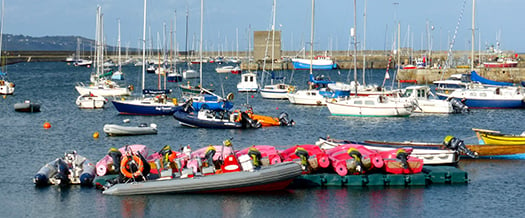
Space is so constrained that a floating dinghy park has to be used to store the smaller craft. Photo: W M Nixon
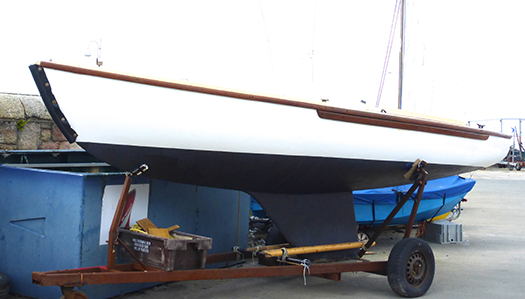
Thanks to the special INSS fendering devised by Arthur Rumball, this 35-year-old Squib has survived many seasons of tough teaching in good order. Photo: W M Nixon
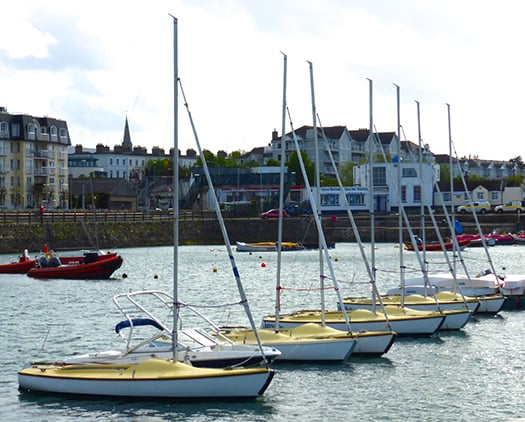
To economise on space, the Squibs berthed here, with the INSS building in the background, are double-moored. Photo: W M Nixon
Of which more anon, for this bare outline gives only a hint of the INSS's complex programme. The Rumball theme is that you have to keep operations and facilities flexible to cope with fluctuating demand, for at the height of the season the school is operating a fleet of 200 boats ranging from kayaks through sailing dinghies of increasing size, then on into keelboats of which some well-fendered Squibs are the workhorses while 1720s provide the glamour input, and finally at the top of the tree there's the Reflex 38 Lynx, bought from Galway this past winter, and becoming part of a programme headed by Alistair's son Kenneth – a Silver Youth Medallist in the 420 – who is now a fully-qualified offshore racing pro teacher, but also races the 1720s while being main operations director of a school which has five full–time employees, but in all has sixty staff at the height of the season.
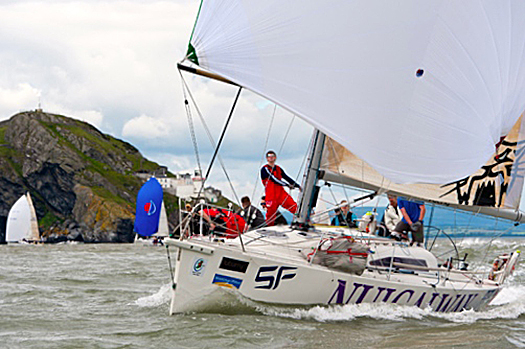
The latest addition to the INSS fleet is the Reflex 38 Lynx, seen here racing for NUI Galway during the Round Ireland. In 2015, Lynx has already scored a second overall in ISORA racing skippered by Kenneth Rumball.
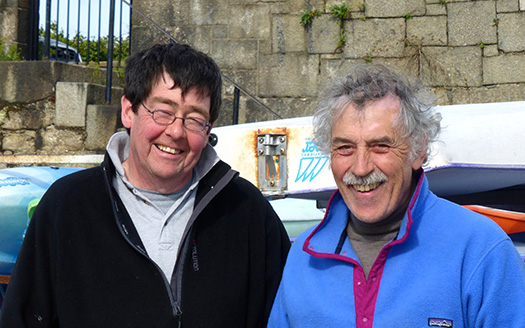
Brothers in business – seen here with his brother Alistair, Arthur Rumball (left) runs the often very busy INSS boat maintenance facility. Photo: W M Nixon
As to shoreside facilities, each summer they set up an additional seasonal summer base to the west of the West Pier with top-of the-line Portakabins at Salthill to provide facilities for those sailing dinghies and kayaks, and in addition the INSS have their own boat-maintenance unit under Arthur Rumball beside the boatyard in the Coal Harbour.
So an impressive amount of things have happened since 1978, the best of them surely being that Alistair persuaded Muriel, a country girl from one of the most beautiful parts of County Carlow, to marry him. For Muriel is a teacher by profession, and adept at being the peace-maker who smooths the waters after Alistair has been making waves, which even now still seems to be just about all the time.
That said, he gives the impression of having so many chips on his shoulder about the perceived opposition to his ventures by those in authority that you begin to think it might be just a bit of an act, for underneath it all he has a heart of gold, yet with the spirit of a lion who will fight the good fight to defend his territory and the interests of his family, friends, trainees and businesses.
The quality of the man was well revealed when the economic recession struck. At the height of the boom years, the Irish National Sailing School had a throughput of more than 2,500 people per month coming new to sailing, and it had become a vibrant and trendy part of the recreational fabric of good-time Dublin. Then around 2008, the economy went into free-fall. But the INSS survived both by making severe cutbacks in everything, and utilising another string in Alistair's bow.
Because of his ready enthusiasm to undertake just about everything and anything to do with boats, back in 1982 he'd looked after some waterborne scenes with classic small craft for the Channel 4 TV comedy-drama series The Irish RM, starring Peter Bowles and Bryan Murray, which went out between 1983 and 1985. It was grand at the time, but thirty years down the line it now seems to have a dose and more of the Paddywhackery about it. However, that was neither here nor there for Alistair Rumball in 1982, for it gave him a lucrative little sideline, and over the years since he has been the man to go to if you want to set up boats and sailing ship scenes in the Irish movie-making business.
So it's ironic, when we remember that Malahide was where the rather mouldy old Vikings of Dublin made their last base after their city had been captured by the Normans in 1171, that it should be a Malahide boy who has emerged as the behind-the-scenes captain of ships for the filming of the blockbuster series Vikings.

When you've spent most of your working life teaching people to sail, tutoring Thespian Viking crewmen on a Wicklow lake is just an ordinary part of another day at the office.
It has all been happening for some years now up in the Wicklow mountains and out on the Wicklow lakes, which have passed themselves off very well as Norwegian fjords, yet can double quite effectively as the coastal and riverside scenery of the many places where the Norwegian Vikings wreaked mayhem.
Who knows, but maybe with the passage of time the epic Vikings series will come to be seen as the epitome of Scandiwhackery, but for now, it certainly does the business . For as the Irish economy fell off a cliff, Alistair Rumball soared aloft in creating, managing, and manoeuvring a very authentic and substantial Viking longship flotilla which has provided a proper Tinseltown income to make all things possible, while helping underwrite the future of the Irish National Sailing School.
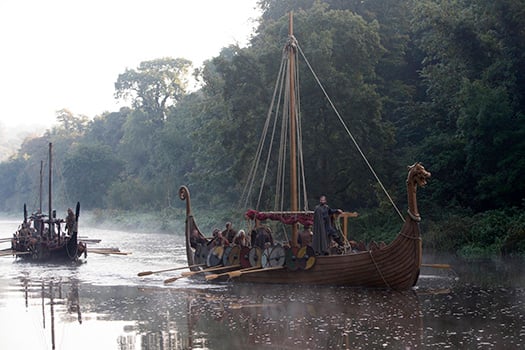
Lough Dan in County Wicklow - where Erskine Childers first sailed around 1890 – has proved remarkably versatile in providing backgrounds for the Vikings which could either be Norway itself, or else the shores of places they are raiding
But it's extraordinarily demanding and time-consuming work, even if he has a staff of 150 specialists up in the Wicklow hills, and after a year or two it became clear that he was trying to do too much. So four years ago his son Kenneth, who is now 27 and was at the time working as an accountant, moved in to take over the direction of the sailing school, and as the recession has started to recede – last year they had monthly numbers pushing back towards the 2,000 mark - Kenneth's energetic and all-encompassing input is seeing the school increasing the scale of its operations, particularly in what might be called the post-graduate side with the development of 1720s at top race level. Now the acquisition of Lynx has developed things further - she has already made what was a rather hasty debut in the first ISORA of the year, but despite being only minutes out of the box, they placed second overall, and that only by six minutes.
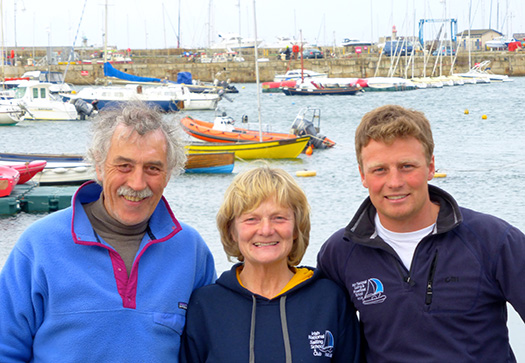
Alistair, Muriel and Kenneth Rumball. Photo: W M Nixon
This placing of racing as a natural part of the INSS syllabus has in turn led to the need for an officially-constituted club to comply with race entry requirements. But in reality the INSS has had a genuine club atmosphere for years, indeed it has more of a truly club-like atmosphere than many a historically-constituted old yacht club. So it was only a formality to bring the Irish National Sailing Club into being in January 201, but it's for real, here's a pic of the Committee of the new club meeting in the old Tom Walsh building on Monday, and if you want to join, it will cost you the outrageous sum of €10.
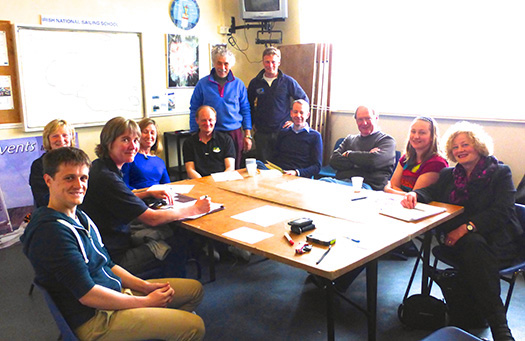
The committee and school management of the newly-formed Irish National Sailing Club are (left to right) Glyn Williams (foreground), Muriel Rumball, Joan Sheffield, Caroline Herron, Robin Jones, Alistair Rumball, Kenneth Rumball, Garrett O'Malley, Dermot Igoe, Heather Blay and Mary Beck. Photo: W M Nixon
As to how Alistair Rumball views the impending possible re-structuring of Dun Laoghaire as a cruise liner port, with inevitable limitations on the amount of sailing which can take place within the harbour, he is both an idealist and a realist.
Like many of us, he dearly wishes that this splendid granite creation could be seen as a cherished part of our heritage, not as something to be used to generate income to turn a crude profit or even just to pay its own maintenance costs. Rather, we'd ideally like to see it treated as a national asset to provide vital recreational space for everyone afloat and ashore.
But Alistair Rumball senses that the government's determination to use just about everything in public ownership to generate income will win the day, and he is already being realistic about what the regular if summer-emphasised arrival of cruise liners will mean.
In fact, he may even derive a certain sardonic satisfaction from seeing the Dun Laoghaire sailing establishment having to contemplate accepting conditions with which his school has complied ever since he began operating it.
"People should realise" he asserts, "that there are already two clearly-define shipping channels in Dun Laoghaire Harbour. One is from the harbour entrance to St Michael's Wharf, which will simply be retained if the cruise liners come. The other, much less widely known, is supposed to be from the harbour entrance to the berth at the Band Stand on the East Pier. Even at present, you are not meant to operate under sail in either of those channels, but an awful lot of boats do so."
"However, as we are a commercial operation, we have a strict policy of complying with regulations and carrying out our sail training and teaching operations in the western part of the harbour, clear of the main channel. So a cruise liner should not affect our in-harbour activities, while our larger craft going out into the bay will have to comply with shipping regulations in the entrance like everyone else".
Whatever happens, we may be sure that the Irish National Sailing School and the Irish National Sailing Club - and their splendid founder - will continue to be a thorn in the side of those who take themselves too seriously and have an inflated idea of their own importance. But if you've never been in a boat before and know nobody in sailing, yet feel a growing enthusiasm to go sailing in Dun Laoghaire, you now know where to go to experience the real thing.
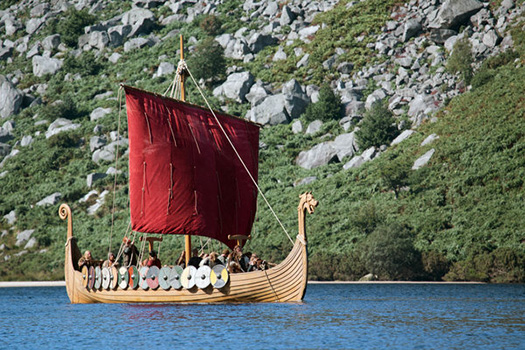
The other side of the INSS show – a Viking ship looking good on Lough Dan





























































